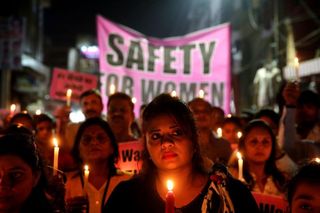
Where Is the Safer Environment for Women the Government Promised in 2012?
Despite a flurry of reforms following the 2012 Delhi gang-rape/murder, the State has done nothing to ensure women’s safety.

In December 2012, India’s Parliament and public were forced to confront the issue of rape and violence against women. After the brutal gang rape, torture, and murder of a woman in South Delhi, protests broke out in the streets of the capital demanding justice for her. Within days, the government at the time made several promises to ensure the safety of women.
Seven years on, the reality remains grim. According to the most recent data (2017) by the National Crime Records Bureau, India registers around 90 cases of rape per day. Additionally, 331 of the rape cases registered in a year culminate in murder.
What happened to the promise of a safer India for women? Despite ample funding and initial reaction-reforms, the promise has died on the vine, leaving the day-to-day safety and access to justice for India’s women largely unchanged.
A flurry of reforms
Following the December 2012 Delhi gang-rape case, the government’s first step was to set up a three-member judicial committee headed by the former Chief Justice of India, J.S. Verma, to amend the laws pertaining to violence against women. The Justice Verma Committee, as it came to be known, invited suggestions from the public and submitted its report within a month to Parliament after reviewing 80,000 petitions and suggestions from the public. This resulted in the passing of the Criminal Law (Amendment) Act, 2013, the most notable aspects of which were: the change in definition of rape to include penetration of any kind; raising the age of consent to 18 years for women; clearly defining sexual assault and mandating sentences of no less than seven years for rape. The Act also added other acts of violence against women to the Indian Penal Code — voyeurism, sexual harassment, acid attack, and stalking.
The government also mandated fast-track courts to deal with rape cases and ensure swifter justice. In such courts, cases would be heard daily and concluded within two months.
Related on The Swaddle:
Why the Police Killing the Hyderabad Rape Accused Isn’t Justice
The government updated the Code of Criminal Procedure and Evidence Act, too, to make the “character of the victim” totally irrelevant during court proceedings and to presume “no consent” in a case where sexual intercourse is proven and the victim states in the court that she did not consent. In May 2013, the Supreme Court ruled that the two-finger test, which was frequently used to determine a woman’s claims of rape, is unconstitutional, saying “it violates the right of rape survivors to privacy, physical and mental integrity and dignity.”
The momentum continued until March 2014, when the Union Health Ministry came up with medical guidelines for providing first aid to rape victims, asking all hospitals to set up designated rooms for such forensic and medical examinations. At the time, the government also directed doctors to record the history of the assault, examine the victim, and offer psychological assistance if need be.
A change in legal theory, not in legal practice
Despite the legal provisions being in place, the realities on the ground are completely different. The lack of efficient implementation has been so egregious, it amounts to denying survivors their right to justice, write Sunita VS Bandewar, Amita Pitre, and Lakshmi Lingam in the Indian Journal of Medical Ethics.
Courts have consistently disregarded the very legal reforms the government promised would serve justice in sexual assault cases. According to Bandewar, Pitre and Lingam, one of the most landmark examples of this include the Jindal Global Law School Case, in which a student charged others with gang-rape. The initial trial concluded in a conviction and sentence, but ultimately reached the High Court, which not only suspended the sentence but also granted bail to all accused, noting the woman’s friendship with them and her history of sexual activity suggest “the narrative does not throw up gut-wrenching violence, that normally precede or accompany such incidents.” Thus, the High Court not only victim-shamed and blatantly promoted the sexist idea that rape is a matter of boys being boys and the misguided notion that rape only occurs accompanied by extreme, brutal violence – but also clearly violated the Indian Evidence Act reforms that direct courts to ignore survivors’ sexual history and character.
The second example is the Farooqui case, wherein the Delhi High Court dismissed the minimum seven-year judgment and Rs. 50,000 fine of the trial court, while also victim-shaming and disregarding the Indian Evidence Act. “Instances of woman behavior [sic] are not unknown that a feeble ‘no’ may mean a ‘yes’,” the court misogynistically wrote.
Related on The Swaddle:
Women Are Hypervigilant About Safety. This Is the Toll It Takes.
Fast-track courts (FTCs) have, quite simply, failed to manage swift justice. The government approved only last year the proposal to set up an additional 1,023 FTCs, which are still under construction. The shortage of judges – 600 in lower courts and 400 in higher courts — adds to the problem of delivering swift justice. The result is, according to Union Law Minister Ravi Prasad Shankar in response to a question in the Lok Sabha, 6 lakh cases currently pending in the FTCs that have managed to be established, and 1.7 lakh cases of rape and 1.6 lakh cases under the Protection of Children from Sexual Offences (POCSO) Act eligible for FTC trial yet to begin.
Police, too, have ignored the legal reforms that should dictate their response to questions of women’s safety. According to complaints made by the family members of the 2019 Telengana rape-murder victim to the National Commission of Women, the Hyderabad police refused initially to file a missing person’s complaint on their behalf, assuming the “victim must have eloped with someone.”
A glut of money – and nothing to show for it
If there is one clear marker of how low women’s safety is on our national list of priorities, it has to be the utilization of the Nirbhaya Fund, set up to fund the reforms and initiatives in the wake of the 2012 Delhi gang rape-murder. According to information released by the Ministry of Women and Child Development in July this year, not even 20% of the money has been put to use since 2013. The fund has received proposals to increase the number of CCTV cameras at railway stations and to procure forensic kits for sexual assault cases – but has financed none. It has doled out for some schemes, like the setup of emergency response (including medical aid and forensic labs) and victim compensation, but these efforts lack enthusiasm and are not up to the mark (some are yet to be fully set up, despite repeated reminders from the Supreme Court).
In the last five years, the Union Home Ministry has released from the fund Rs. 1,656 crores to states and Union Territories toward efforts to make a more safe environment for women; of this, the states and the UTs combined have only been able to give utilization certificates of Rs. 146.98 crore — less than 10% of the money released. What’s even more shameful is the fact that six states and territories have not even spent a penny of the Nirbhaya funds allotted to them: Maharashtra, Meghalaya, Manipur, Sikkim, and Daman and Diu. It reeks of willful disdain for women’s safety considering, in the last records revealed by the crime branch, Maharashtra had a year’s total of 4,306 cases of assault on women – the sixth highest in the nation; the state also had the second-highest number of kidnappings of women. Yet, Maharashtra was among the 11 states that did not utilize even a penny apportioned to it by the Department of Justice out of the Nirbhaya Fund.
To top this, half of all Indian states and UTs have given zero transparency into how they used funds sanctioned to set up emergency response systems for women. Even victim compensation has stalled and has to be monitored by both the Supreme Court and various state High Courts. For instance, Madhya Pradesh came under fire last year after it came to light that the state had distributed only 1 crore to 1,951 women subjected to assaults.
Most recently, the government has allocated 100 crores out of the Nirbhaya Fund to set up help desks for women, in order to make “police stations more women-friendly and approachable, as they would be the first and single point of contact for any woman walking into a police station,” the Union Home Ministry said in a statement.
When and how effectively these will be implemented, only time will tell. But one thing is clear: the Indian state has repeatedly failed its women citizens by acting on their safety with only half-hearted corrective measures and never with priority or prevention.
Gunjeet Sra is a writer and columnist based out of New Delhi, who writes about gender and politics. She is also the co-founder of Subculture Media and the editor of sbcltr.in, a counterculture website aimed at empowering marginalized narratives.
Related


Birds Are Shrinking Because of Climate Change, Study Finds
